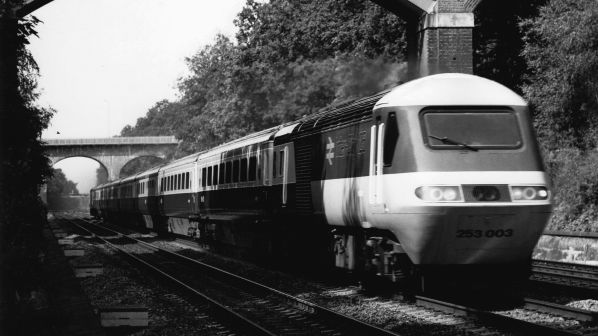1960
October: Pilot issue of IRJ published.
Bids are invited for the rehabilitation of an 844km section of the Hedjaz Railway from Ma’an, Jordan, to Medina, Saudi Arabia. (Only the Jordanian section was ever rebuilt).
1961
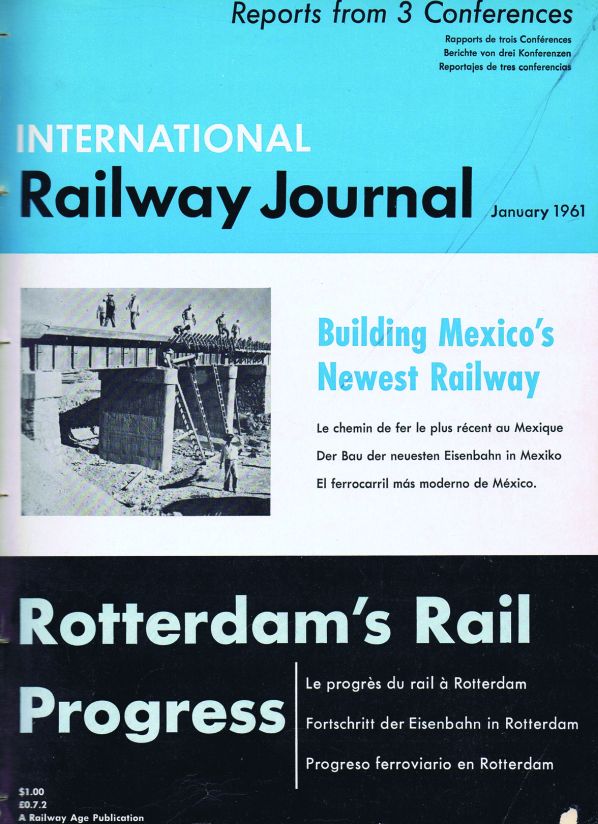
January: Publication of IRJ as a monthly magazine begins. The Soviet Union announces a 15-20 year railway development programme including the construction of 19,000km of new lines in Siberia.
May: IRJ interviews Dr Richard Beeching, the new chairman of the British Transport Commission, who says the system may not be the right size.
1962
January: The 938km Chihuahua Pacific Railway opens in Mexico, 62 years after construction started.
February: Completion of the standard-gauge link in the Australian state of Victoria cuts the Melbourne - Sydney transit time for freight in half.
August: IRJ reports from Berlin on the severing of rail links following construction of the wall separating the two halves of the city in 1961.
November: The world’s first crewless freight trains start operation on a 10km line in Labrador, Canada, hauling crude ore 24-hours a day.
1963
April: China draws up a 15-year plan to build 33,000km of new lines, which would more than double the size of the 30,203km network.
May: BR chairman Dr Richard Beeching publishes his infamous report to close lines, cut passenger services and boost freight with new “liner” trains.
June: Swiss study 45km tunnel to relieve the existing St Gotthard tunnel. The new tunnel will ultimately open in 2016.
1964
March: JNR begins drilling pilot shafts for a tunnel under the sea between Honshu and Hokkaido. April: The British and French governments agree to proceed with a railway tunnel under the English Channel. “It seems there may be a considerable delay before the project is started due to numerous problems which still have to be settled.”
July: London Transport starts driverless operation on a 6.4km section of the Central Line.
October: Japan opens New Tokaido Line, the world’s first high-speed railway. The 515km standard-gauge line linking Tokyo with Osaka has a maximum speed of 210km/h. IRJ’s founder, Robert G Lewis, reports from Japan on this milestone in railway history.
1965
January: Senator Claiborne Pell proposes the introduction of 160km/h services on the Boston - New York - Washington DC corridor, similar to that provided on Japan’s New Tokaido Line.
May: Spanish National Railways (Renfe) launches a $US 1.3bn 10-year modernisation programme.
July: German Federal Railway (DB) launches its first 200km/h service using an E03 locomotive.
1966
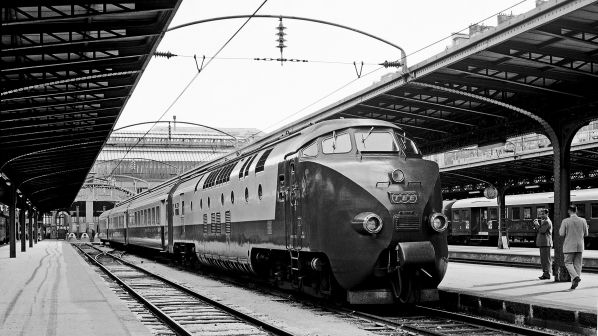
Photo: Brian Stephenson
January: Europe is about to adopt a standard automatic coupler, but it will cost $US 2bn to implement.
June: France tests Aérotrain on 6km track. Speed was limited to 135km/h on first tests in February, but later trials should reach 200km/h.
1967
March: JNR launches construction of the New Sanyo Trunk Line from Osaka to Okayama.
The Arab League approves construction of a 500km Gulf railway from Iraq via Kuwait to join the existing line in Saudi Arabia.
July: Construction is approved of a 426km heavy-duty line from Port Hedland to Mount Newman in Western Australia.
Canadian National and New Haven Railroad prepare to launch revolutionary TurboTrains built by United Aircraft Corp (but they are bedevilled by numerous technical problems).
October: Work is underway on the first metro line in Mexico City.
1968
February: The Pennsylvania Railroad and the New York Central are allowed to merge to form the ill-fated Penn Central.
June: Budd emus - later known as Metroliners - for Penn Central’s New York - Washington DC line reach 270km/h in tests.
October: The first section of London Transport’s automated Victoria Line opens.
1969
October: The first 12km section of Mexico City’s first metro line opened in September.
December: Construction of the first 9.6km section of the planned 157km Washington metro to start this month following Senate approval.
1970
February: Maglev trains could be flashing at 500km/h between Tokyo and Osaka by 1980 if proposals by JNR’s Technical Research Institute are accepted.
May: Four US railways merge to form Burlington Northern.
June: Work is to start this summer on the first 120km of the Rome - Florence Direttissima, Europe’s first high-speed line.
October: Construction starts this month of the 1852km Tanzam from Kapiri Mposhi, Zambia, to the Tanzanian port of Dar es Salaam funded by China.
1971
March: German Federal Railway (DB) approves plans to build 2200km of fast mainline track and upgrade 1250km over the next 15 years.
April: Japan’s Railway Construction Council approves the New Tohoku Line, New Joetsu Line, and the New Narita Line (which was never built as a high-speed line).
May: Amtrak took over the operation of about half of the remaining long-distance passenger services in the United States. Only three railroads continue to operate their own passenger services.
BR unveils its experimental gas-turbine Advanced Passenger Train (APT) with a design speed of 250km/h.
November: Krauss-Maffei’s linear motor experimental Transrapid maglev train reaches 150km/h at its unveiling in Munich. The train is designed for 500km/h operation.
1972
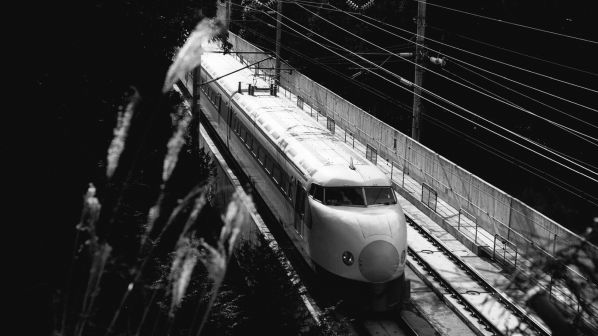
February: Groundbreaking ceremonies are held for the construction of Japan’s New Tohoku and New Joetsu lines, while the 181km New Sanyo Line (pictured) is due to open on March 15.
April: Poland starts construction of the first 143km section of the Central Trunk Line from Radzice south of Warsaw to Zawiercie north of Katowice. The line is designed for 250km/h operation, a speed which trains have yet to reach.
May: Munich opens its first S-Bahn and U-Bahn lines on May 28 in preparation for the opening of the Olympic Games in August.
BR rolls out a prototype 200km/h diesel High Speed Train.
June: The first two experimental gas-turbine TGVs designed for 300km/h operation have been handed over to French National Railways (SNCF) for testing.
July: The first section of San Francisco’s Bay Area Rapid Transit (Bart) broad-gauge network is scheduled to open on September 1.
December: Construction of Kolkata metro - India’s first metro - begins.
1973
March: Indian Railways begins construction of the 900km Konkan railway.
April: Feasibility studies are underway for metros in Delhi, Bombay and Madras.
July: Iscor, South Africa, awards contracts for the construction of the 860km Sishen - Saldanha Bay iron-ore railway.
November: DB starts work on Hannover - Kassel - Gemunden high-speed line, while China considers construction of a high-speed line using Japanese technology.
1974
February: A bill is signed by President Nixon to merge bankrupt railways in the north east, including Penn Central, to set up Consolidated Rail Corp (Conrail) to operate them.
May: Full automated operation starts of the new 50kV ac Black Mesa & Lake Powell Railroad in the US state of Arizona.
August: Soviet State Railways (SZD) starts trials with ER-200, a 200km/h electric train, on the Moscow - Leningrad line.
October: The 1852km Tanzam (Tazara) Railway opens, two years ahead of schedule.
Construction starts in the Soviet Union of the 3150km Baikal Amur Magistral (BAM).
1975
September: China completes its first electrification project covering the 676km Paoki - Chengtu line.
Britain’s Advanced Passenger Train (APT) sets a new British speed record of 243km/h.
November: Construction starts of Hong Kong’s Mass Transit Railway metro.
1976
February: Work starts in Brazil on the so-called Steel Railway, a 403km electrified line linking Belo Horizonte and Redonda.
April: SNCF orders two 10-car pre-series and between 85 and 95 series-production 260km/h trains from Alsthom and Francorail-MTE for operation on the new Paris Sud-Est high-speed line to Lyon.
German Federal Railway (DB) has the go-ahead to build the 100km Mannheim - Stuttgart high-speed line.
Yugoslavia’s 476km Belgrade - Bar line opens - construction started in 1952.
May: South African Railways starts running export coal trains on the new line from the Transvaal to Richard’s Bay.
September: Indian Railways inaugurates electric services on the 1441km Delhi - Calcutta line, the first trunk route to be electrified.
November: BR launches the world’s fastest diesel service, the 200km/h HST on the London - Bristol/Swansea main line (pictured).
December: Fiat’s new tilting Pendolino train is now operating between Rome and Ancona.
1977
March: Italian president, Giovanni Leone, inaugurates the first section of the Rome - Florence Direttissima between Rome and Citta della Pieve.
May: South Korea reveals proposal for Seoul - Busan
high-speed line.
1978
February: Vienna’s first U-Bahn line opens with the launch of services on the Reumannplatz - Karlsplatz section of Line U1.
April: Canada’s Via Rail takes control of Canadian National’s passenger fleet and takes over Canadian Pacific passenger operations in October.
May: Edmonton becomes the first city in North America of less than 1 million inhabitants to open a light rail network.
1979
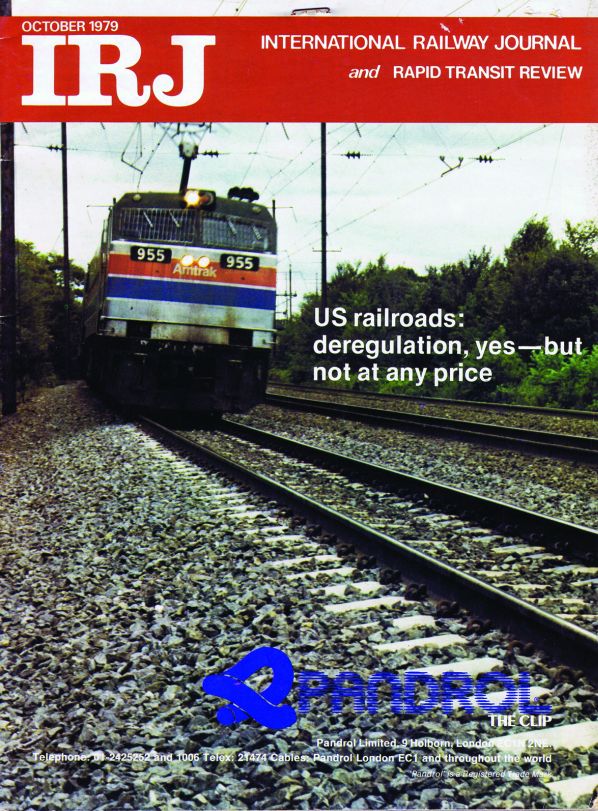
April: Amtrak announces the withdrawal of 43% of its services, covering 19,000 route-km.
October: The first 8km stretch of Hong Kong’s Mass Transit Railway opens. The section is part of the 15.6km Kwun Tong Line.
1980
February: Missouri Pacific and Union Pacific announce plans to merge, creating a 34,000km network. By July railways with 191,000 route-km or 63% of the US mainline network, are in merger talks as they seek consolidation to improve profits.
August: The New Zealand government agrees to finance electrification of the 410km North Island Trunk Railway between Palmerston North and Hamilton Te Rapa.
October: Alice Springs joins Australia’s standard-gauge network with the opening of the 835km line from Tarcoola.
1981
February: An SNCF TGV sets a new world speed record of 380km/h on the new Sud-Est high-speed line, beating the previous record of 331km/h set by SNCF in 1955.
September: The initial section of TGV Sud-Est, France’s first high-speed line, is opened by President François Mitterrand on September 22.
December: Britain’s tilting Advanced Passenger Train (APT) makes its first revenue run between London and Glasgow. Production trains are expected to enter service by 1984, but technical problems mean the project is eventually scrapped.
1982
January: A consortium of 17 European companies is selected to build the 380km stretch of the Trans-Gabon Railway from Booué to Franceville. The line is completed in 1987.
June: The first section of the Tohoku Shinkansen opens between Omiya and Morioka.
July: The Japanese Prime Minister’s Administrative Reform Council proposes breaking up the deficit-ridden Japanese National Railways (JNR) into smaller privately-run units. JNR lost $US 4.2bn in the 1981-82 financial year and spent $US 2bn servicing its debts.
1983
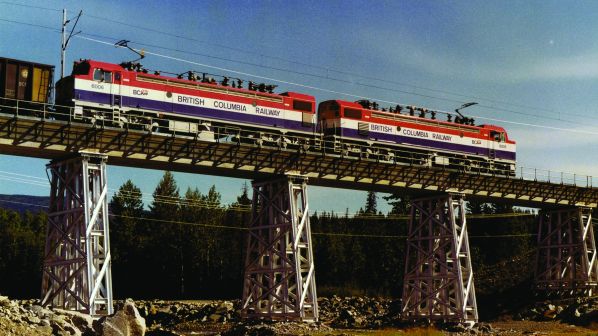
March: Egyptian National Railways (ENR) receives its first 10-car Turbotrain from ANF-Industrie, France, for operation on Africa’s first scheduled 160km/h service, linking Cairo and Alexandria.
April: The first VAL automatic metro line is inaugurated in the French city of Lille.
October: National Railways of Zimbabwe runs its inaugural Freedom Train service between Gweru and Harare to celebrate the completion of 25kV electrification on the Dabuka - Harare line.
December: Canada’s first mainline electrification scheme is completed when BC Rail opens its new 129km Tumbler Ridge line in British Columbia (pictured). Sadly traffic never reaches expected levels and the last electrically-hauled train runs in 2000, with the line closing completely soon after.
1984
May: China approves the upgrading and electrification
of the 630km Datong - Qinhuangdao Railway, one of the country’s key arteries for coal traffic.
Soviet engineers lay the final section of track on the 3150km Baikal Amur Magistral (BAM) at Balbukhta, Siberia. The first train travels over the whole route a month later.
September: Beijing opens second metro line after a 15-year gap.
1985
February: Following a bidding war with Chicago & Northwestern, Soo Line completes its acquisition of the ailing Milwaukee Road.
Construction begins on France’s second high-speed line, TGV Atlantique.
August: Saudi Railways Organisation opens the 310km direct line between Riyadh and Al Hufuf, reducing journey times between the capital and Dammam.
1986
January: Britain and France agree to build a rail-only Channel Tunnel.
Commercial services begin on Vancouver’s SkyTrain Expo Line automated light metro.
August: Albanian Railways is linked to the European network for the first time with the opening of the 60km line between Shkoder and Titograd. Services are suspended two years later.
1987
April: After 38 years, Japanese National Railways is broken up into smaller units as a prelude to privatisation.
Soo Line sells its 3140km Lake States division to private investors, forming the new Wisconsin Central Transportation Corporation.
The regional railway goes on to play a major part in the privatisation of railways in Britain, New Zealand, and Australia before it is swallowed up by Canadian National in 2001.
May: Fourteen European railways agree to launch the EuroCity network of high-quality international services to replace the TEE network.
November: Singapore opens its first metro with the inauguration of the Yio Chu Kang - Toa Payoh stretch of the North South line.
1988
March: Almost 17 years after construction started, Japan opens the Seikan Tunnel between the islands of Honshu and Hokkaido. The 53.85km-long tunnel reaches a depth of 240m below sea level, making it the world’s longest and deepest railway tunnel, a title it will retain until the opening of the Gotthard Tunnel in 2016.
May: Germany opens its first high-speed line with the start of services on two sections of the Hannover - Würzburg line.
Suburban networks in north and south London are reconnected with the launch of the Thameslink network.
July: Sweden becomes the first country in Europe to separate infrastructure and operations, with SJ splitting from newly-formed track authority Banverket.
1989
May: Limited public services begin on the world’s first 300km/h railway. TGV Atlantique cuts journey times between Paris and Rennes/ Nantes by 40min to 1 hour.
September: SJ begins test operation of its first ASEA/ABB X2 tilting inter-city train, which is marketed as X2000. A fleet of 43 X2s enter service in Sweden from 1990.
1990
January: Cash-strapped Via Rail announces plans to slash its network from 38 routes to just 18. The cuts reduce the number of services from 405 to 191.
May: A shortened TGV Atlantique train brings SNCF and Alsthom another world speed record, reaching 515.3km/h.
The first scheduled inter-city service between West and East Germany is launched between Frankfurt and Leipzig, Cologne - Berlin and Leipzig - Nuremberg/Munich.
August: South African Transport Services runs a 7.3km-long, 70,800-tonne iron-ore train on the 861km Sishen - Saldanha line. The train consists of 660 wagons hauled by nine 50kV electric locomotives and seven diesel locomotives.
December: A consortium of US and local companies led by Iowa Interstate and Techint is named as the first concessionaire to take over part of the Argentine Railways (FA) network.
British and French construction teams meet under the Channel for the first time on December 1 with the historic breakthrough of the service tunnel.
1991
June: DB launches its ICE high-speed network between Hamburg, Hannover, Frankfurt, Stuttgart and Munich.
SNCF orders its first double-deck TGVs in a $US 1.77 billion contract with a GEC-Alsthom-led consortium for 45 trains.
1992
April: King Juan Carlos of Spain opens the country’s first high-speed line. Construction of the 471km Madrid - Seville line began in October 1987 and the line shaves 103km off the existing route.
September: Tram-train services are launched in Karlsruhe using 10 dual-voltage Duewag/ABB LRVs on DB and tram lines.
October: Swiss voters approve the AlpTransit plan for construction of the Lötschberg and Gotthard base tunnels.
1993
June: Trial operation begins on the first section of the Shanghai Metro.
September: The New Zealand government announces the sale of NZ Rail to a Wisconsin Central-led consortium for $US 219 million.
October: JR East is listed on the Tokyo stock exchange.
1994
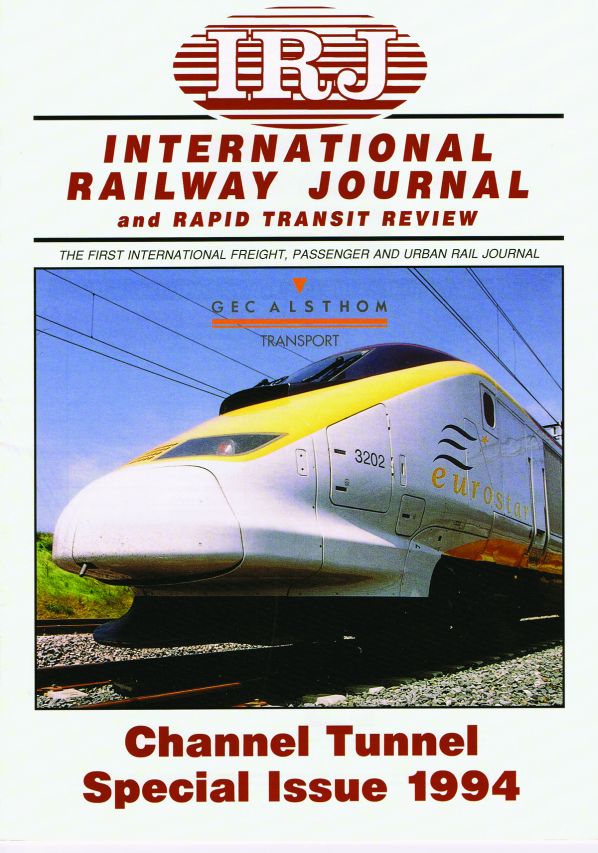
January: DB and DR are unified to form German Rail.
March: Construction starts on the 204km Rome - Naples high-speed line.
April: Railtrack assumes control of British Rail’s infrastructure assets, marking the start of the break-up of the national railway.
May: Queen Elizabeth II of Britain and French president, François Mitterrand, officially open the Channel Tunnel. Freight shuttles begin in June and car shuttles start in October.
October: Plans for a rail link to Stockholm Arlanda Airport are approved.
November: Eurostar launches London - Paris/Brussels high-speed services.
1995
February: A double-deck TGV is tested for the first time.
September: Burlington Northern and Santa Fe merge in a $US 4bn deal, while Union Pacific and Southern Pacific also merge in a deal worth $US 5.4bn. BNSF and UP are now the sole Class 1 freight railways in the western United States.
1996
June: Thalys launches high-speed services between Paris, Brussels and Amsterdam.
December: JR East says it has been profitable since 1990 thanks to privatisation.
1997
January: Fire breaks out on a freight shuttle, seriously damaging the Channel Tunnel.
Great Belt fixed link between eastern and western Denmark opens.
1998
January: Australia establishes a national track authority for the standard-gauge inter-state network.
July: A Munich - Hamburg ICE crashes killing 98 passengers near Eschede. (A broken tyre is cited as the cause).
August: GEC Alsthom becomes Alstom following a successful flotation on the New York, London and Paris stock exchanges. At FFr 25 bn it is believed to be the biggest ever sell-off of a private company in Europe.
September: Eastern US Class 1 railway, Conrail, is taken over by Norfolk Southern and CSX.
1999
March: DaimlerChrysler buys ABB’s 50% stake in Adtranz for $US 472 million.
Series 700 Shinkansen train enters service achieving speeds of 280km/h.
May: Japanese Maglev train reaches 552km/h.
September: Øresund link between Denmark and Sweden is completed.
November: Britain suffers its worst railway accident in 30 years when 31 people are killed and 520 injured at Ladbroke Grove, near London Paddington. The accident brings into question the priorities of the privatised railway.
2000
March: DM 10bn Maglev project between Berlin and Hamburg is abandoned.
ERTMS specs agreed.
August: Spain announces Pesetas 19bn investment plan, paving the way for the development of dedicated 1435mm-gauge high-speed lines.
September: Bombardier agrees deal to purchase Adtranz for $US 725 m.
October: China builds 305km/h Blue Arrow, its first high-speed train.
2001
January: Japan completes privatisation of JR East, JR Central and JR West.
The Acela passenger service is launched on the United States’ northeast corridor.
March: Contract awarded for a maglev line in Shanghai, China - the first and last commercial application of German maglev technology.
July: Reforms of Russian Railways (RZD) are approved.
November: Britain’s private infrastructure manager Railtrack collapses after amassing debts of £3.3bn. Network Rail is formed to take its place in April 2002 as a not-for-profit company.
2002
May: Swiss Federal Railways (SBB) launches ETCS Level 2 on a 35km line between Sempach and Zefingers, the first to enter service.
August: 177km Frankfurt - Cologne high-speed line opens.
December: Leuven - Liège section of Brussels - Frankfurt high-speed line opens.
Delhi opens its first metro line, an 8.3km stretch from Shahdara to Tis Hazari.
2003
February: Electrification of the Trans-Siberian railway is completed.
July: Privatisation of the rail network in the Australian state of Victoria fails.
September: The southern section of Britain’s 70km High Speed 1 rail link from the Channel Tunnel to London opens.
November: Spain opens the first section of the Madrid to Barcelona high-speed line a year later than planned.
2004
January: Australia’s 1420km Alice Springs - Darwin line opens five months ahead of schedule.
February: Bordeaux light rail network opens partly utilising Innorail, a ground power supply system instead of catenary.
May: Europe agrees to the Second Railway Package paving the way for open-access freight services and the creation of the European Railway Agency.
Korea’s first high-speed line is inaugurated between Seoul and Daegu.
August: Alstom is bailed out by the French government.
December: Hitachi wins its first European train contract to build 30 six-car 225km/h EMUs for domestic services on Britain’s HS1.
2005
May: Iran opens $US 405m 805km Mashhad - Bafq line, well ahead of the original 2007 date.
June: Japan suffers its worst accident since 1963 when a JR West EMU derails and hits a building near Osaka, killing 107.
October: The first cross-border ETCS application is activated on the 245km Vienna - Budapest line.
November: Testing begins on the 1142km Qinghai - Tibet railway which took just four years to build and is the highest railway in the world.
2006
January: IRJ celebrates the success of its campaign to save the Penzance - London Paddington sleeper service.
July: Berlin’s new central station, which provides a high-capacity mainline terminal for the first time since World War II, opens.
October: Siemens breaks the world speed record for an electric locomotive, reaching 357km/h.
November: Laos begins construction of its first 3.5km railway link.
Maglev accident in Germany kills 23 and calls into question the use of the technology and its safety credentials.
December: Taiwan’s first high-speed line, the 345km Taipei -Kaohsuing link, is inaugurated.
2007

May: French smash world speed record when a TGV/ AGV hybrid test train reaches 574.8km/h on TGV Est.
June: The first trains for more than half a century travel across the demilitarised zone between North and South Korea.
July: TGV Est, the 300km route from Paris to Strasbourg, opens - the first in France designed for commercial 320km/h operation.
The 34.6km Lötschberg base tunnel opens, 24 years after the project was originally proposed, and eight years after construction began.
August: European Parliament and Council announce details of the Third Railway Package which includes laws to promote greater competition, interoperability and passenger rights. It came into force in 2009.
December: The northern section of HS1 opens to a substantially rebuilt London St Pancras.
2008
June: New Zealand returns Toll, the country’s largest rail operator, to state ownership. Toll becomes KiwiRail in November.
Argentina signs contract with Alstom-led Veloxia consortium for the proposed 710km Buenos Aires - Rosario - Cordoba high-speed line. The economic crisis means the project fails to secure funding.
August: China opens 115km Beijing - Tianjing high-speed line, its first 350km/h railway.
Beijing opens three metro lines ahead of Olympic Games.
September: A collision in Los Angeles claims 25 lives after a Metrolink commuter train collides with a Union Pacific freight train, prompting federal legislation mandating the rollout of Positive Train Control across the United States.
2009
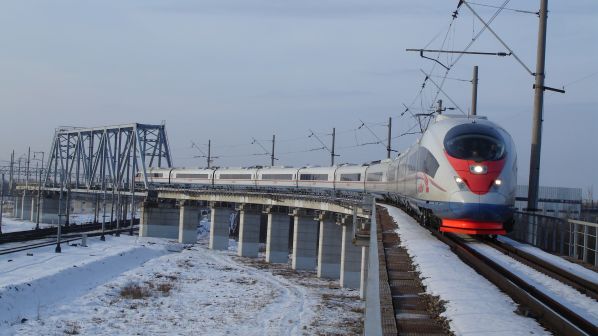
January: France announces plans to construct four high-speed lines totalling 699km for a total of €13.4bn.
March: Hitachi is selected as the preferred bidder for Britain’s IEP programme, a deal potentially worth £7.5bn.
May: Mr Hartmut Mehdorn resigns from DB amidst an employee spying scandal. He is replaced by Dr Rüdiger Grube.
July: Belgium opens a 42km high-speed line from Liège to the German border.
October: Dubai’s first metro line, the Red Line from Emirates to Rashidiya, is inaugurated.
November: Sweden launches Trafikverket, a comprehensive transport authority.
December: Warren Buffet’s Berkshire Hathaway purchases the remaining 77.4% stake in BNSF for $US 26.6bn.
Russian Railways launches Moscow - St Petersburg Sapsan high-speed services (pictured).
2010
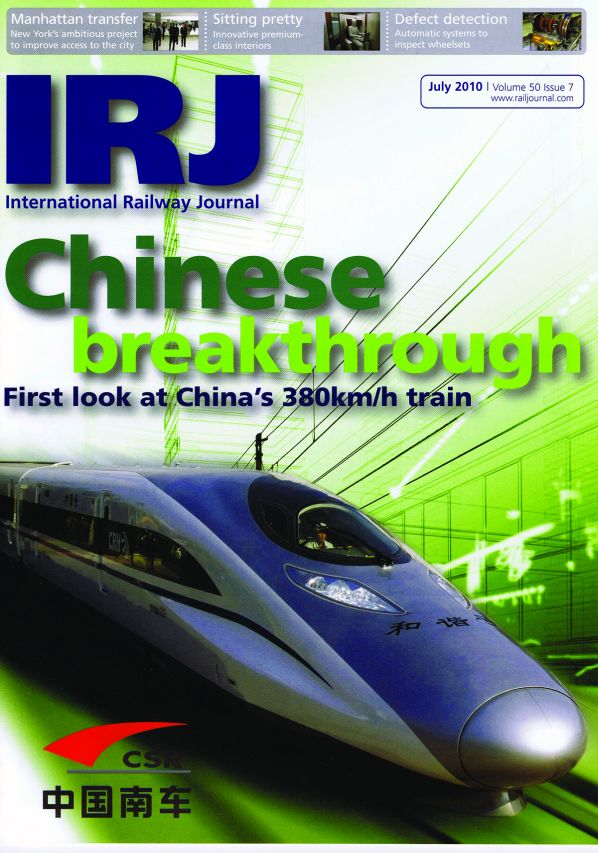
May: DB takes over British operator Arriva, which has passenger operations in five countries.
July: CSR unveils 380km/h train CR380A, and the 301km Shanghai - Nanjing 350km/h line opens.
August: Thirteen EU states face court over liberalisation failures under the terms agreed in the First Rail Package.
December: Services begin on the Daegu - Busan high-speed line in Korea, the final section of the Seoul - Busan line.
The 124km Madrid - Valencia high-speed line opens.
Helsinki - St Petersburg Allegro Pendolino service starts.
2011
March: Major earthquake in northeastern Japan causes widespread disruption to Tohoku Shinkansen.
May: DB and Siemens sign a contract worth up to €6bn for ICx long-distance trains, which would later be branded ICE4. The first train enters service in September 2016.
June: Chinese premier, Mr Wen Jiabo, inaugurates the 1318km Beijing - Shanghai high-speed line. Construction on the $US 34bn project began in 2008 and was completed ahead of schedule.
July: A crash at Wenzhou, China, in which 40 people died, is the first fatal accident on a high-speed railway and prompts the Chinese government to review high-speed train operation, cutting the maximum speed from 350km/h to 300km/h.
August: Turkey opens its second high-speed line, the 212km link from Ankara to Konya.
Jerusalem opens the 13.8km Red Line, the city’s first light rail line.
October: JR East’s Advanced Train Administration and Communications System (Atacs) debuts on the Senseki commuter line in Sendai.
December: Westbahn launches open-access services on the Vienna - Salzburg route in direct competition with ÖBB.
2012
January: The British government approves construction of the first 191km phase of HS2 between London, Birmingham and Crewe. The cost has since exploded to more than £80bn.
Banedanmark selects a joint venture of Thales and Balfour Beatty, and Alstom for contracts to resignal Denmark’s entire 2132km network with ETCS Level 2. The project is now scheduled for completion in 2030.
April: The world’s first open-access high-speed operator, NTV Italo, launches between Milan, Florence, Rome and Naples in competition with Trenitalia.
May: Fred Green is ousted as president and CEO of Canadian Pacific (CP), as hedge fund Pershing Square capital prevails in efforts to reform the Class 1, installing former CN chief, Hunter Harrison, the pioneer of Precision Scheduled Railroading (PSR). Harrison is installed as CEO of CSX in 2017 as PSR expands across the Class 1s.
ETCS Level 3 enters operation on the Västerdal freight line in Central Sweden. It remains the only commercial deployment of the moving block technology.
September: The European Court of Justice rules in favour of the integrated railway structure adopted by DB and ÖBB.
December: Siemens announces plans to purchase Invensys Rail for $US 2.8bn.
2013
January: Perpignan - Figueres 1435mm-gauge line opens across the France-Spain border.
EC unveils the Fourth Railway Package, which breaks from the gradual push to vertical integration, and calls for the liberalisation of all domestic passenger markets from December 2019. Full market opening is not now scheduled until 2023. ERA will issue vehicle authorisations, which it assumed for all EU member states in October 2020.
March: China abolishes the Ministry of Railways, shifting administrative responsibility to the State Railways Administration, which is part of the Ministry of Transport. China Railway Corporation is established to operate the national network.
April: SNCF launches its Ouigo low-cost high-speed service.
July: A derailment at Santiago de Compostela, Spain, kills 79 people after a high-speed train passes through a curve designed for 80km/h at 180km/h. An investigation found that the accident was caused by driver error and a lack of a functioning onboard ETCS system.
Three contracts worth $US 22.5bn are awarded for the design and construction of the six-line 176.7km Riyadh Metro. The first lines are due to open later this year.
October: Turkey inaugurates the 13.3km Marmaray tunnel beneath the Bosphorus, connecting the Asian and European sides of Istanbul by rail for the first time.
December: EC adopts the €1bn Shift2Rail public-private seven-year research project through which the EC more than triples its funding for railway research.
2014
January: A 1500m freight train operates in Europe for the first time as part of the Marathon project.
March: JR East’s first battery EMU enters service on the partly electrified line between Utsunomiya and Karasuyama.
June: Mumbai opens its first metro line, the first in India to use a PPP model.
General Electric buys Alstom’s power division, with Alstom purchasing GE’s railway signalling division.
July: The 245km Eskisehir - Istanbul section of the 533km Ankara - Istanbul high-speed line opens. Trains beneath the Bosphorous are introduced following the completion of the reconstruction of Gebze - Istanbul - Halkali line in March 2019.
August: Kazakhstan opens the 988km east-west Kezkazgan - Shalkar - Beinue, and 214km north-south Arkalyk - Shubarkol lines.
October: Vienna inaugurates new €987m Main Station.
The governments of Estonia, Latvia, and Lithuania establish RB Rail, which will oversee construction of the 728km Rail Baltica standard-gauge project, which will open in 2026.
Etihad Rail launches trial operation of the 264km Shah - Habshan - Ruwais line, the UAE’s first railway.
December: China’s CNR and CSR agree terms of merger, which will create CRRC, the world’s largest railway equipment supplier.
2015
January: California officially breaks ground on the Central Valley section of the high-speed project, although construction is underway on a 45km section of the Fresno - Madera line.
February: Cosan Logistics’ $US 3bn takeover of Brazilian rail freight operator Latin American Logistic (ALL) through its Rumo Logistics subsidiary is approved.
March: The 228km Hokuriku Shinkansen from Nagano to Kanazawa opens.
MTR Express begins operating Stockholm - Gothenburg services in competition with SJ.
April: KTX Honam services begin on Korea’s 182.3km Osong - Gwanju high-speed line.
August: Wabtec agrees $US 1.8bn deal to acquire Faiveley Transport.
September: CRRC breaks ground on Springfield, Massachusetts, plant.
November: 11 people die in an accident during testing of the TGV-Est high-speed line between Paris and Strasbourg following a derailment at Eckwersheim, 12km north of Strasbourg.
Hitachi concludes deal with Finmeccanica to purchase AnsaldoBreda and Ansaldo STS.
Indian Railways finalises orders with GE and Alstom worth a combined Rs 450bn to purchase 1800 locomotives, which will be manufactured at two new plants in the country.
December: Germany’s €2.74bn Erfurt - Leipzig/Halle high-speed is inaugurated.
2016
January: Construction begins on Indonesia’s first high-speed line between Jakarta and Bandung. The line is scheduled to open in the second half of 2021.
March: High-speed services on the 148.8km Hokkaido Shinkansen from Shin-Aomori via the 53.8km Seikan tunnel to Shin-Hakodate-Hokuto begin.
Uzbekistan’s capital Tashkent announces plans to close its 90km tram network and sell its fleet of 80 trams.
April: Indian Railways launches the Gatimaan service from Delhi to Agra, its first 160km/h passenger train.
June: Switzerland inaugurates the 57.1km Gotthard Base Tunnel, the world’s longest tunnel.
Construction of the €25bn Grand Paris orbital express metro network begins.
July: Nigeria inaugurates the 185.5km Abuja - Kaduna standard gauge line.
September: China’s high-speed network surpasses the 20,000km mark with the opening of the 360km Zhengzhou - Jiangsu line.
The Moscow Central Ring railway is opened by Russian president, Vladimir Putin.
October: The 752km Ethiopia - Djibouti electrified standard-gauge line is inaugurated.
Austrian Federal Railways (ÖBB) and DB reveal plans for ÖBB to take over several night-train routes in Germany.
2017
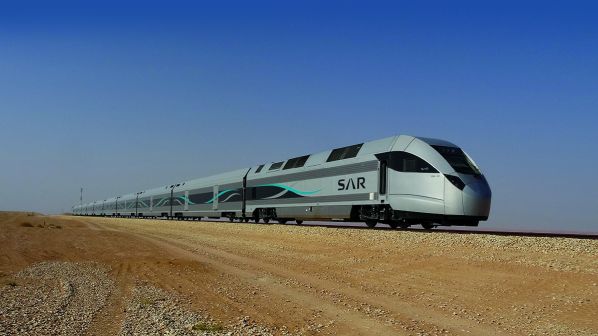
February: Saudi Railway Company (SAR) launches passenger services on the Riyadh - Al Qassim section of the North-South Railway.
May: The inaugural service on Kenya’s 472.3km Standard Gauge Railway from Nairobi to Mombasa is flagged off.
July: SNCF opens two extensions to its TGV Atlantique network: TGV Océane from Tours to Bordeaux and TGV Bretagne-Pays de la Loire from Le Mans to Rennes.
August: The Karlsruhe - Basle Rhine Valley line is closed following the collapse of the line at Rastatt, causing widespread disruption to European rail freight services.
October: A ceremony is held at the Port of Baku to mark the official completion of the 826km Kars - Tbilisi - Baku railway.
December: The final section of the 623km Berlin - Erfurt - Nuremberg - Munich high-speed line opens.
2018
January: Privately owned US operator Brightline launches services between West Palm beach and Fort Lauderdale.
February: Govia Thameslink Railway, in cooperation with Network Rail and Siemens, operates a train in passenger service using ATO GoA 2 over ETCS.
July: Cambodia’s Phnom Penh - Thai border line reopens after 45 years.
September: Saudi Arabia inaugurates the 453km Haramain high-speed line from Mecca to Medina.
The first two Coradia iLint hydrogen multiple units (HMU) enter service in Lower Saxony, the first time that hydrogen-powered trains have been used for commercial passenger services.
October: Transnet Freight Rail (TFR), South Africa, completes a successful test run with a 375-wagon train, with the 4km-long train carrying 22,500 tonnes of manganese ore.
November: The 183km Tangiers - Kenitra high-speed line is officially launched. Africa’s first high-speed railway cost €1.8bn and took seven years to build.
2019
February: Wabtec completes $US 11.1bn takeover of GE Transportation.
March: Jakarta opens 15.7km metro Line 1.
May: Denmark opens the Copenhagen - Ringsted line, the country’s first high-speed railway.
June: Rio Tinto completes the transition to the entirely automated operation of its 1500km iron-ore railway in the Pilbara region of Western Australia.
September: CRRC Zhuzhou agrees to buy Vossloh Locomotives.
December: China opens the 174km Beijing North - Zhangjiakou line, the world’s first automated high-speed line.
2020
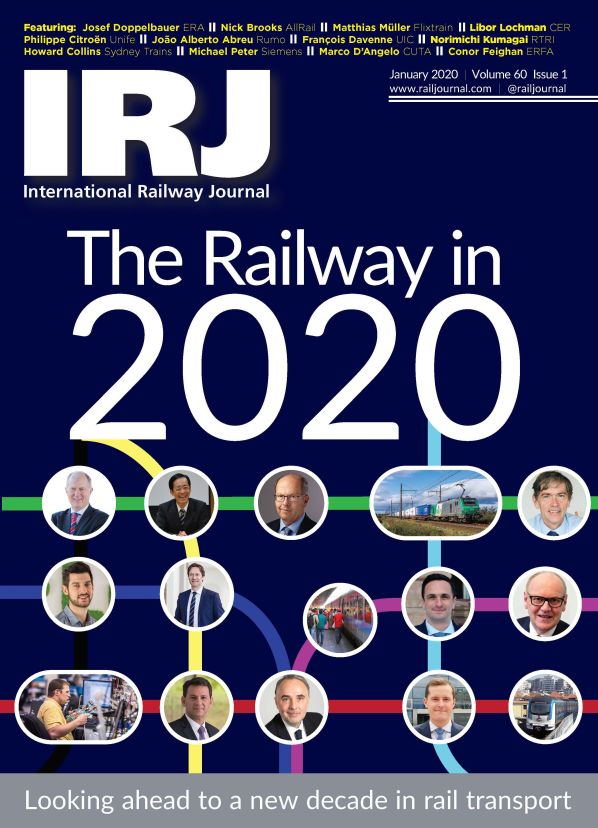
February: China National Railway (CR) reports year-on-year reductions in passenger traffic of more than 80% as the government tries to curb the spread of Covid-19 following an outbreak in Wuhan, which results in a city-wide lockdown.
Two drivers are killed and 31 people are injured when a Trenitalia ETR 1000 high-speed train derails south of Milan, the first fatal accident involving a commercially operated European high-speed passenger train on a high-speed line.
March: The Covid-19 pandemic sparks national lockdowns across the world. Passenger rail traffic plummets by up to 95% as governments step in to prop up ailing operators and transit authorities. Passenger numbers remain suppressed for the remainder of the year and in early 2021.
September: Switzerland officially opens the 15.4km Ceneri Base Tunnel ahead of the start of passenger services in December.
December: Rollout of Positive Train Control (PTC) is completed on all 92,575 required freight and passenger railway route-km, which is used by 41 railways including Amtrak and all seven Class 1s.
The Singapore - Kuala Lumpur high-speed project is cancelled.
2021
January: Alstom completes its acquisition of Bombardier Transportation.
